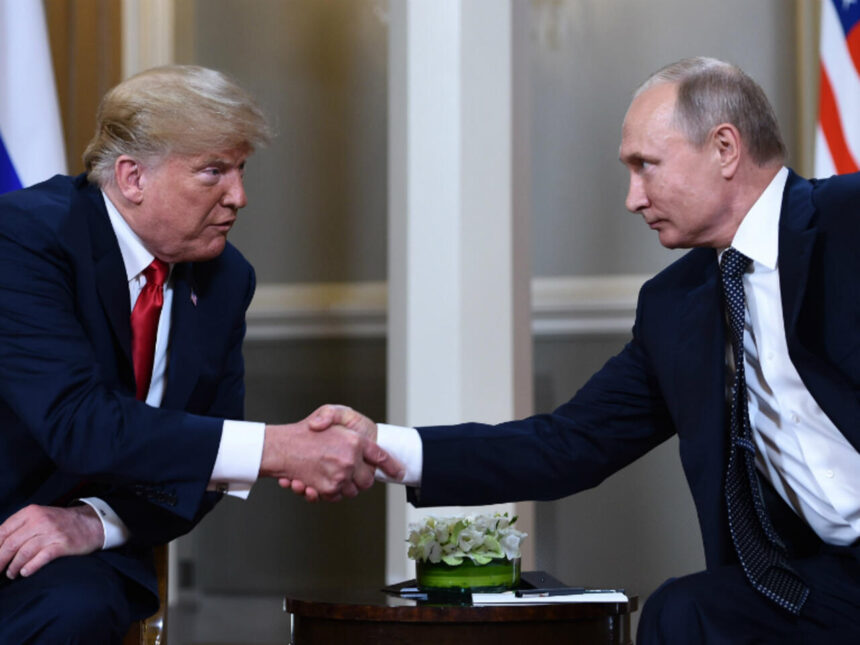Beverly Gauge explores a long historical relationship of American conservatism with foreign authoritarian regimes in a piece on how the American far right has lionized and aligned with dictators abroad. Review of America Last, where Jacob Heilbrunn documents the open admiration that Donald Trump had for foreign strongmen such as Vladimir Putin and Viktor Orbán.
Gauge begins by noting how, since the New Deal, the resilience of the American right was consistently under-rated by American liberals. In 1950 Lionel Trilling judged conservative thought “irrelevant.” But less than a decade later, via the John Birch Society, McCarthyism, and the candidacy of Barry Goldwater nothing could seem more relevant — and, far from being a phenomenon of the distant past, conservatism kept resurging and finding new voices to carry its banner: Richard Nixon and Ronald Reagan among them, even after Lyndon Johnson had triumphed over Goldwater so convincingly in 1964.
Reagan’s success in 1980 saw to the turning of this corner; by then, conservatism could no longer largely be seen as somehow undeserving of American or mainstream. Still, though, a significant portion of liberals remained in denial, holding the belief that some aspects—nativism, racism for instance—remained on the peripheries of the mainstream, so Trump’s ascension in 2016 revealed that these attitudes were more widespread on that far right than most on the left cared to realize.
A New Era of Scholarship
Historians—from Alan Brinkley in the 1990s to, more recently, Rick Perlstein in the anguished aftermath of Trump’s election—have tried to make sense of the genealogy of conservative and far-right ideas, examined organizations like the John Birch Society, and even domestic fascism. These have almost entirely focused on domestic politics, and in consequence, they virtually all miss something fundamental to the modern right: its enthusiasm for foreign autocrats, argues Gauge.
This is where Heilbrunn’s America Last comes in. This book takes Trump’s adulation of other dictators and places it in a century-long American right lineage of fascination with autocracy.
Heilbrunn, who has existed in neoconservative and then neoliberal circles, describes far-right U.S. admiration for leaders as diverse as Putin and Orbán as part of a more general American conservative tradition of authoritarians as foreign. In admiration for such leaders, Heilbrunn suggests that this view is not just geopolitically pragmatic but stems from a true belief in democracy’s inferiority versus authoritarianism.
As Heilbrunn notes, his research begins with World War I, for he sees that at that time some Americans even liked Kaiser Wilhelm II of Germany for his perspective on the situation with nationalism and militarism. Even though it is true that the ultimate results were U.S. military disputes with Germany, this admiration was the basis for further pro-authoritarian sentiment or, to put it more precisely, the support of Mussolini in Italy and Hitler in Germany in the 1920s and 1930s. To these American intellectuals and politicians, Hitler’s anti-communism and nationalism, however hateful, were preferable to creating an alliance with liberal forces.
He also pointed out that American right-wing intellectuals have spread anti-democratic and hierarchical ideas, involving people like William F. Buckley and Lothrop Stoddard. National Review, by William F. Buckley, sang praises for many types of dictators, such as Francisco Franco in Spain, Rafael Trujillo in the Dominican Republic, and Augusto Pinochet in Chile, among others. This fit into that wider tendency of American conservatism to pay tribute to those strongmen who best embodied order and tradition, whatever the brutality of their rule.
Transition to the Mainstream
Heilbrunn saw that the deference to authoritarianism by Trump has entered right into the mainstream of politics. Far-right figures like Buckley worked from outside the center of power, and the Trump victory had taken ideas from the former to the front line of American politics. It is not so much that Trump likes Putin, Orbán, and other leaders for their political astuteness, but it is because he looks upon authoritarianism as a preferable and more efficient universal view compared to liberal democracy.
Elite Grievance and Ivy League Conservatives
Ironically, Heilbrunn points out that many of the leading lights in this far-right authoritarian tradition, including Buckley and Trump, were Ivy Leaguers. This gives the dynamic of conservatives who went to Ivy League schools turning on the very elite institutions that socialized them into denouncing liberal intellectuals and universities while, at the same time, embracing principles of authoritarianism.
Power and Influence
While Heilbrunn does a valuable job in taking the measure of these far-right figures, as Gauge points out, the book does a poor job of really exploring how influential their ideas have been on American policy. Trump, of course, clearly adopted many of these ideas with open arms, but it is far less clear how significantly they shaped the course of his administration or the wider conservative movement. However, Heilbrunn’s book shows how a fringe set of ideas that was once seen as eccentric waters the roots of American conservatism today.
Conclusion:
In this review, Gauge argues for the importance of understanding the history of adulatory authoritarianism on the American right. Far-right ideas on foreign dictators had, in recent decades, acquired much more credibility than would have previously been thought possible before the advent of Trump and the grabbing of authoritarianism by the broader right, seen since as mainstream when it originally seemed on the fringe and extreme. This transition suggests that the United States may be entering uncharted territory and poses a significant challenge to the principles of liberal democracy.
Read the original article here.







